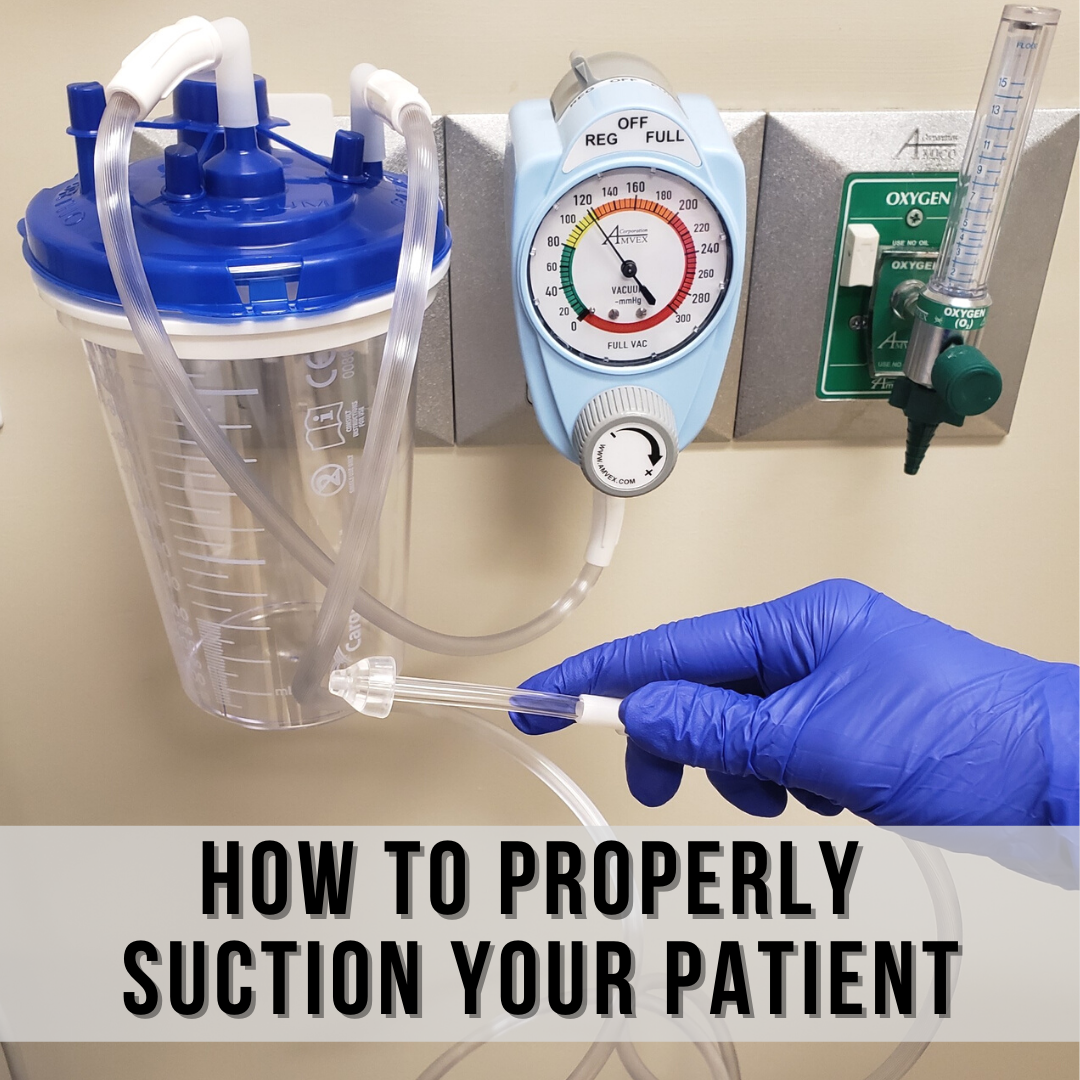How to Properly Suction Your Patient

Suctioning seems pretty easy when you think about it, right? You are pretty much just removing mucous from someones airway BUT how to properly suction your patient actually requires a lot more knowledge than you think. Think about it, each time you suction your patient’s airway, you aren’t just removing secretions, you are also removing oxygen. This is why there are certain techniques to follow when properly suctioning your patient. The goal is to not only achieve a good suction that leads to airway clearance, but that your patient does not decompensate while you are doing it. Let’s go through the steps below.
Step 1
Gather equipment. Seems pretty obvious but it is so frustrating when you forget something that is essential to a procedure and have to keep coming in and out of the room. You also don’t want to give the impression that you are unprepared (although this by no means signify you don’t know what you are doing, perception can sometimes sway your patient’s experience).
Step 2
Introduce yourself, provide privacy and verify your patient’s information. This is pretty self-explanatory. You must do this prior to any procedure on a patient.
Step 3
Place patient in a Semi-fowler’s position and ensure suction regulator is working properly. Believe it or not, there are times when you turn on the suction block or regulator and it isn’t even working. You test this by turning on the regulator and intermittently feeling for a vacuum seal with your gloved finger at the end of the tubing (you should feel your finger being sucked in by the tube). One of the first steps in how to properly suction your patient is to always make sure both your suction and oxygen are working prior to suctioning. You might ask, “Why check oxygen? I’m only suctioning”. Well, you don’t want to be caught in a situation where your patient needs oxygen after a suction and your oxygen isn’t working. Always check that both are working properly.
Step 4
Protect yourself and your patient. Make sure you have the appropriate PPE on. This includes gloves and a shielded mask. Depending on the patient’s isolation precautions you may also require a gown. If possible, place a towel over your patient’s chest to prevent any transmission of secretions and/or saline from splashing over.
Step 5
Set up and hyperoxygenate if indicated. Open suction kit and catheter with clean gloves while using a clean technique if it is a bulb suction device such as a BBG (pictured in the title picture) and using aseptic technique if it is a deep catheter suction. If indicated, hyperoxygenate your patient or ask them to take a few deep breaths right before procedure.
How to properly suction your patient when using a BBG:
- Turn suction machine to proper setting according to order.
- Attach BBG and make sure it is working properly by testing suction again.
- Suction each nostril for a couple seconds intermittently to remove any mucous trapped in the nasal passage.
- If the order indicates use of 0.9% saline during suction you can instill a couple drops per nostril (one nostril at a time) and begin intermittent suction. (e.g., a couple drops of saline in one nostril and intermittently suction that same nostril).
- Another way to suction is by using a neti-pot method, instilling saline in one nostril while suctioning through the other. This should only be done for a couple seconds at a time.
Some tips I have learned through clinical experience and other nurse educators on how to properly suction a patient and facilitate secretion drainage is:
- While suctioning, you can massage the sinuses to allow that mucous to break up.
- The BBG is a flexible bulb syringe catheter (should never be stiff). Move it around different angles while snug on the nose to be able to suction certain areas in the nasal passage. This is the purpose for this flexibility.
How to properly suction a patient when using a sterile suction catheter:
- Turn suction machine to proper setting according to order.
- Open the water-soluble lubricant and squeeze a small amount onto sterile field.
- Perform hand hygiene and don sterile gloves.
- Fill your sterile basin with sterile 0.9% NS.
- Using dominant hand, test suction catheter in the sterile water in basin.
- Lubricate the suction catheter with the lubricant.
- Gently rotate the catheter while following the natural path of the nasal passage to the back of the pharynx, always assessing your patient while doing this. If your patient coughs or any resistance is met along the way stop and withdraw.
- Apply intermittent suction while rotating the catheter for 10 seconds as you withdraw.
- Assess your patient and apply oxygen if needed.
- If there is a need to repeat suctioning allow 20 seconds between each session.
Note* your patient’s vital signs should always be monitored while performing deep suction. Vitals signs that are important while deep suctioning are SpO2, HR and BP. Some patients are sensitive and a deep suction can easily trigger a vagal response (causing sudden decrease in heart rate & BP). If there are any changes in vital signs, stop and withdraw immediately providing adequate care as indicated.
Always, always, always keep an eye on your patient while suctioning, no matter the method. Assess them. If they look like they are in any form of distress, STOP immediately and withdraw. You will apply oxygen as needed and notify the physician of any changes.
…and viola! YOU ARE ALL DONE! Hope you guys enjoyed this post and it helped you gain some tips on how to properly suction your patient. Stay tuned for more posts coming soon and comment below any other topics you would like me to go over.
Patient Education Question
What are some important tips to educate parents on when performing suction at home? Comment below!
’till next time,
The RN Educator
Disclaimer: This post is not intended to be used as medical advice. It is only intended as educational content.
Share this:
Related Posts
What’s in a Pediatric Crash Cart? Nursing Students read NOW!
A pediatric crash cart is a mobile unit containing essential equipment and medications required for…
Share this:
How to Become a Confident Nurse
If you are anything like me, and let’s face it (like every nurse…



